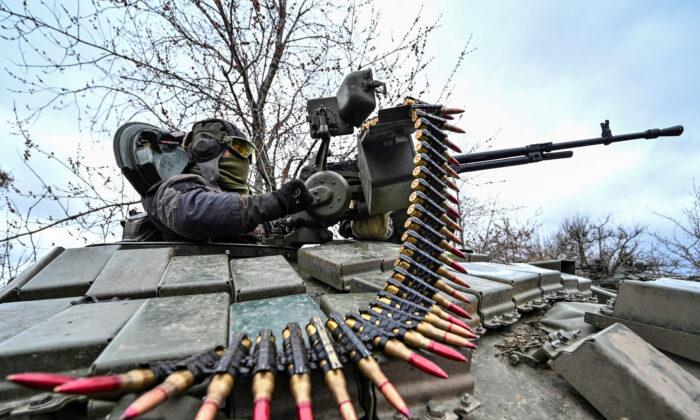Several classified documents that detail U.S. and NATO plans to assist an anticipated springtime Ukrainian counter-offensive appear to have been leaked online, according to mainstream media reports.
On April 6, The New York Times reported that the documents—which contain sensitive military information—had been posted on Twitter and Telegram and were being shared on pro-Russia social media accounts.
“We are aware of the reports of social media posts, and the Department [of Defense] is reviewing the matter,” Pentagon spokeswoman Sabrina Singh said on April 7.
The leaked information includes arms-delivery schedules, troop sizes, and other logistical data, according to the NY Times article, which cites a “senior Biden administration official.”
While it doesn’t contain detailed battle plans, the data represent a “significant breach of American intelligence in the effort to aid Ukraine,” the newspaper asserts.

Ukrainian servicemen atop a tank near the bombed-out eastern city of Bakhmut, in the eastern Donetsk region of Ukraine, on April 2, 2023. Violeta Santos Moura/Reuters
The article also cites military analysts who claim the documents “appear to have been modified in certain parts from their original format,” raising concerns about their authenticity.
The Pentagon hasn’t explicitly confirmed the legitimacy of the documents in question.
The reports appear to have prompted Ukrainian President Volodymyr Zelenskyy to convene a meeting with top military advisers to discuss means of preventing leaks of classified information.
According to an April 7 statement released by his office, meeting participants “focused on measures to prevent the leakage of information regarding the plans of the defense forces of Ukraine.”
Counter-Offensive Expected
Recent weeks and months have seen Russian forces achieve slow but decisive gains, especially in the eastern Donetsk region.But they have also seen growing indications that a Ukrainian counter-offensive—bolstered by Western arms and support—is imminent.
On April 5, U.S. Secretary of State Antony Blinken, speaking at NATO headquarters in Brussels, called on allies to remain “focused intensely on the weeks and months ahead ... as Ukraine prepares for a counter-offensive, again, to try to retake more of its territory.”
For months, Ukrainian forces have been pinned down in Donetsk’s city of Bakhmut, where they face superior Russian troop numbers and firepower.

Ukrainian presidential adviser Mykhailo Podolyak speaks during an interview with The Associated Press in Kyiv, Ukraine, on Feb. 16, 2023. Efrem Lukatsky/AP Photo
Military experts say the fall of Bakhmut, a key transport hub, would likely pave the way for a Russian advance to the north and northwest.
On April 7, the UK Defense Ministry confirmed Ukraine’s tenuous position in the beleaguered city.
“Russia has made further gains and has now highly likely advanced into the town center and has seized the west bank of the Bakhmutka River,” the ministry said in its daily briefing.
Some indications suggest that the anticipated Ukrainian counter-offensive will attempt to relieve pressure on Bakhmut. Others suggest it will focus on the southern Zaporizhzhia region in hopes of splitting the Russian land corridor to Crimea.
In any event, the counter-offensive—if it happens—will depend heavily on Western support and badly needed Western arms and equipment.
Last month, Kyiv received several German-made combat tanks from both Germany and Portugal, with more reportedly on the way.
Last week, the Pentagon unveiled a new $2.6-billion military assistance package for Kyiv, bringing total U.S. contributions to Ukraine’s war effort to $35.2 billion.
Both Sides Fear ‘Disinformation’
Some officials in Kyiv say the leaked documents are part of a Russian disinformation campaign meant to sow confusion before the upcoming counter-offensive.“These are standard elements of operational games by Russian intelligence,” Mykhailo Podolyak, an adviser to Zelenskyy, said on April 7.
He went on to assert that the leaked information contained “large amounts of fictitious information.”
“Russia is looking for any way to seize back the initiative and ... try to influence the scenarios for Ukraine’s counter-offensive plans,” Podolyak said.
Notably, some pro-Russian sources have also raised the possibility that the leaks were part of a “disinformation campaign”—but by Kyiv and its allies.
“I think it’s a classical disinformation operation being conducted to mislead us; to make us think that they [Ukrainian forces] aren’t ready yet,” Vladimir Rogov, a pro-Moscow official in the Russia-held Zaporizhzhia region, said.
He went on to confirm a “significant buildup” in recent weeks of Ukrainian forces near Zaporizhzhia.
“Equipment continues to arrive, equipment is ready, and enough [Ukrainian] militants have been trained,” Rogov told Russia’s TASS news agency on April 7.
The leaked information, he added, could be intended to “make us think an offensive may only be possible after some time—and not within the next few days.”
Reuters contributed to this report.





